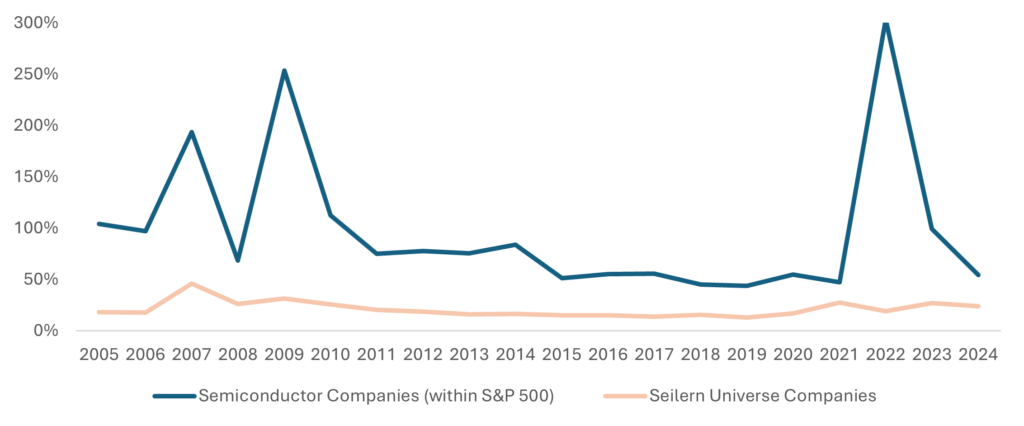Introduction
As our investors will know well, the Ten Golden Rules are the guiding principles which we use to help us find Quality Growth companies. These rules have been the subject of many newsletters laying out in detail the characteristics of companies that can grow their earnings sustainably. What is less often discussed, is the vast number of companies that are excluded from our research because they do not fit this profile.
The Ten Golden Rules are therefore not just a way to identify businesses in which to invest; they also help us to define what is not Quality Growth. While this may seem like two sides of the same coin, it is an important distinction, and one that strikes directly at the core of our investment objectives. While many investors will target some level of returns, the Quality Growth investor takes a different approach and aims to find businesses that combine sustainable earnings growth with a low risk of a permanent loss of capital in the belief that this will yield superior returns over the long run.
This newsletter aims to look at the different exclusions that we apply when searching for new candidates for our Universe and how they help us achieve our objective of finding businesses with sufficient, sustainable, profitable and resilient growth.
Sufficient growth
Finding businesses with sufficient organic growth prospects to grow over the long run is the first step in our exclusionary process and an essential one as we believe that earnings drive share prices over the long run. As long as a company is capable of growing its earnings over time, its share price should follow and compound over the years. Our growth rules, therefore, aim to reduce the risk that our businesses will only achieve lacklustre or stagnant earnings growth, leading to muted share price appreciation.
For that reason, we look for structurally growing industries, with secular growth drivers and we exclude industries which are at risk of becoming mature (growing at or below GDP level), such as telecommunications. The sector offers clear signs of an industry with declining growth prospects. Between 2007 and 2018, McKinsey estimated that the median telecom operator in the US had grown revenues by only +20 per cent (+1.7 per cent CAGR)1 while Roland Berger estimated the top 10 operators had grown revenues at a CAGR of 3.5 per cent between 2010 and 2021.2 As one would expect, the combination of low market growth, a lack of pricing power and growing capital intensity has led to the poor performance of the sector over the last 10 years with the iShares U.S Telecommunications ETF “compounding” at the rate of +0.8 per cent CAGR over the same time frame.3 If earnings drive share prices over the long run, avoiding these sectors that we call “ex-growth” is the first step to finding Quality Growth businesses.
Predictable and sustainable growth
Once we are confident that we have found a business with solid underlying growth we ask ourselves an essential question: is it sustainable? This is important because the value of a business depends on its ability to generate cash flows over the long run. In the discounted cash flow valuation method, the vast majority of a company’s value is captured in the terminal value. This is because it represents the present value of all future cash flows beyond the explicit forecast period, which for growing companies can be very large. This is particularly true for Quality Growth businesses, with the average company in our Seilern Universe deriving more than 85 per cent4 of their value from that terminal value (The price isn’t always right). While attractive short-term growth can be appealing, it is the durability and longevity of that growth that truly matters for investors seeking to compound returns over time.
For that reason, we avoid industries which we think are less predictable or where we think the barriers to entry are not sufficiently robust. One such industry that we have recently discussed is the semiconductor & semiconductor equipment industry whose unpredictability is the result of a combination of rapid technological change, cyclical demand, long lead times to increase capacity, concentrated and complex supply chains and geopolitical factors, making it particularly challenging to forecast over the short term, let alone the medium and long term. An analysis of the earnings forecasts of the 20 largest semiconductor names in the S&P 500 since 2005 shows that there is, on average, a 100 per cent difference between the highest and lowest estimate for one-year forward earnings, more than five times wider than the average for the companies in the Seilern Universe (see chart below).
Figure 1: Average per cent difference between highest to lowest broker forward EPS estimate – 1 year forward

Profitable growth
While earnings growth is a major driver of share prices over the long term, not all earnings are equal. The next step in our search for Quality Growth businesses is to look at Returns on Invested Capital (ROIC) to help us assess the quality of those earnings. ROIC essentially tells us how efficiently a company has been using its invested capital to generate profits. To create value, a company needs to earn more from its investments than it costs to raise that money (either via debt or equity). The higher the ROIC, the better the company is at generating profits and the more valuable it is to its shareholders. Businesses which can sustain high ROIC for long periods of time should ultimately be able to compound earnings at a faster rate. On the other hand, businesses with low ROIC often need to rely on debt to fund their growth, increasing their sensitivity to economic downturns and interest rate hikes. Large capital investments can also take time to come online, constraining growth when demand is high and exposing them to the risk of building what might become excess capacity in the future.
For those reasons we avoid sectors which tend to have high capital requirements and low or unpredictable ROIC such as the energy sector, utilities, basic materials or real estate. The last is a good example of a sector with structurally low and declining ROIC due to high capital intensity. As can be seen in the chart below, according to a 2019 study, the sector’s ROIC averaged only 6 per cent over the previous decade.5 Energy, on the other hand, is an example of a ROIC which can fluctuate significantly depending on the price of the underlying commodities making it hard to predict over time.
Figure 2: Weighted average ROIC by sector since 2000: High variance excluding the Tech Sector

Resilient businesses
Last, but not least, our 10 Golden Rules help us find businesses that can withstand the unexpected economic shocks that will inevitably happen to the long-term investor. These can range from a recession to trade wars and tariffs, inflationary pressures, interest rate hikes, regulatory changes and even the occasional “black swan” event that can leave severe and lasting damage on the economy.
While it is impossible to entirely protect oneself from these risks, we believe they can be mitigated by avoiding industries and businesses which are more exposed to these types of events. One such sector which is heavily exposed to external shocks is the banking sector. Banks, in our opinion, present several issues for the Quality Growth investor: Their business is capital intensive and increasingly regulated; they are selling a commoditized product which limits their pricing power; and their profitability is largely dependent on the level of interest rates. But most importantly, at the core of the issue with banks, is their lack of transparent accounts. Indeed, banks are inherently opaque, and it is virtually impossible for outside investors (and sometimes even for insiders) to assess the quality of their credit risk. The great financial crisis, the savings and loan crisis and the recent Silicon Valley Bank crisis have all shown how mistakes in assessing these risks and unexpected shocks can wreak havoc on a bank’s balance sheet and eventually lead to its collapse.
Conclusion
Quality Growth investing, by definition, mitigates risk in the pursuit of return. Investors who follow this style are like marathon runners who are looking for the fastest sustainable pace over long distances. They are not likely to be the flashiest runners and will routinely forsake short-term speed for long-term endurance. Consistency and discipline over miles and miles are their hallmarks rather than short bursts of exceptional performance.
Consistency and discipline for the Quality Growth investor often means cutting out a variety of companies and industries that lack many of the key characteristics of endurance, even if they appear to be successful in the moment. It is a way for us to reduce the risk of being caught in a business where growth evaporates or where capital requirements mean that participation in that growth becomes an expensive endeavour. Finding companies and sectors that have higher than average predictability and a strong record of weathering external shocks helps us decrease the likelihood of experiencing negative surprises and increases the likelihood of finding companies that can yield superior returns over the long term. By cutting companies that do not meet our strict tests, we can ensure the quality of our investment universe, admitting only the finest companies with the best characteristics. And, as our Chairman routinely reminds us, only the best will do.
C. Massin,
31 October 2024
1https://www.mckinsey.com/~/media/McKinsey/Industries/Technology%20Media%20and%20Telecommunications/Telecommunications/Our%20Insights/Telecom%20operators%20Surviving%20and%20thriving%20through%20the%20next%20downturn/Telecom-operators-Surviving-and-thriving-through-the-next-downturn.pdf
2https://www.rolandberger.com/en/Insights/Publications/Transforming-telcos-Opportunities-and-models-for-telecom-operators.html#:~:text=Average%20revenues%20for%20the%20top,to%20fiber%2C%20in%20quick%20succession.
3https://www.ishares.com/us/products/239523/ishares-us-telecommunications-etf#chartDialog
4Forecast period is five years
5 https://www.newconstructs.com/wp-content/uploads/2019/06/LongTermTrendsRevealedByOurResearchOnSectorROIC_2019-06-17.pdf
This is a marketing communication / financial promotion that is intended for information purposes only. Any forecasts, opinions, goals, strategies, outlooks and or estimates and expectations or other non-historical commentary contained herein or expressed in this document are based on current forecasts, opinions and or estimates and expectations only, and are considered “forward looking statements”. Forward-looking statements are subject to risks and uncertainties that may cause actual future results to be different from expectations.
Nothing contained herein is a recommendation or an offer or solicitation for the purchase or sale of any financial instrument. The material is not intended to provide, and should not be relied on for, accounting, legal or tax advice, or investment advice. The content and any data services and information available from public sources used in the creation of this communication are believed to be reliable but no assurances or warranties are given. No responsibility or liability shall be accepted for amending, correcting, or updating any information contained herein.
Please be aware that past performance should not be seen as an indication of future performance. The value of any investments and or financial instruments included in this website and the income derived from them may fluctuate and investors may not receive back the amount originally invested. In addition, currency movements may also cause the value of investments to rise or fall.
This content is not intended for use by U.S. Persons. It may be used by branches or agencies of banks or insurance companies organised and/or regulated under U.S. federal or state law, acting on behalf of or distributing to non-U.S. Persons. This material must not be further distributed to clients of such branches or agencies or to the general public.
Get the latest insights & events direct to your inbox
"*" indicates required fields





